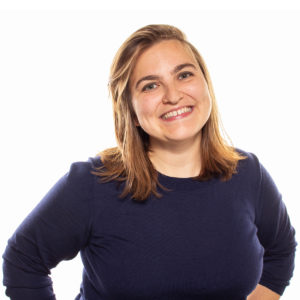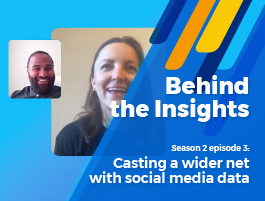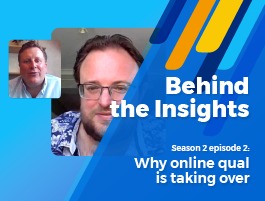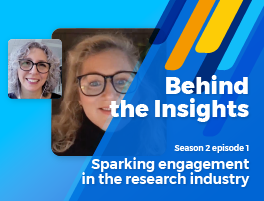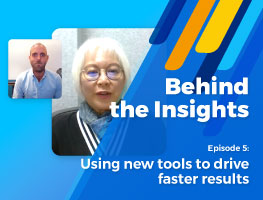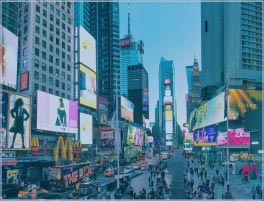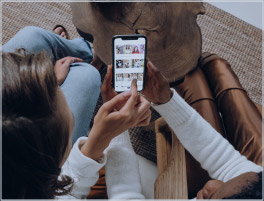Behind the Insights season 2 episode 4
Cutting through the noise: The evolution of creative work and how we judge them
This is Behind the Insights, a vodcast series by MetrixLab. We talk to experts from all over the world to find out what’s really driving today’s hottest topics in brand insights.
In this episode, join MetrixLab’s Global Senior Consultant, Andy Santegoeds, and EY’s Director of Brand Marketing and Communications, Ron Schneider, as they talk about what makes creative work so tricky to create and judge. Whether it’s identifying the different forms of noise that exist within organizations, or ensuring that your ads retain that human touch, we’ve got you covered! Find out what lies behind making and judging true creative content in our episode below. It could be the boost your campaigns need to take your brand to the next level.
Check it out and stay tuned for more episodes every month!
Or if you prefer, read the full transcript below.
Intro: Welcome back to Behind the Insights, a vodcast series by MetrixLab. We talk to experts from all over the world to find out what’s really driving today’s hottest topics in insights
Andy: Hi and thank you, everyone, for joining us for another episode of Behind the Insights vodcast by MetrixLab. My name is Andy Santegoeds, I’m a global senior consultant at MetrixLab. And I’m delighted to welcome today, Ron Schneider. Hello Ron.
Ron: Hello, Andy.
Andy: Well, we’ve known each other for quite a while now. We’ve done various projects on various occasions, mostly on the crossroads of marketing and advertising.
Can you give us a bit more background on your current role at EY?
Ron: Thanks, Andy. And as said, we’ve known each other already for a long time. And let me introduce myself quickly. I currently work as a director of brand marketing and communications for EY in the Netherlands. And before that I have had a very long experience in marketing and communications in several Dutch corporates. So, I started my career at Telecom at KPN, the Dutch National Telecom Provider.
I worked for a long time at the Dutch Railway, National Railway Organization, and in my last role I was responsible for marketing at Eneco, which is the largest sustainable energy provider in the Netherlands and in fact, perhaps it’s nice to mention here my first experience with MetrixLab was already in the early days of my career. I think it was around 2004.
And at that time, I was part of a team that was doing a new positioning for the KPN brand, so it was positioning a new corporate style and we came to a certain point where we had three logos to choose from. And that’s always a difficult choice because everybody has an opinion about it and it was also the moment MetrixLab came in.
So, we designed a logo for the logo test, and we tried to find the best logo that fit the KPN values like trustworthiness, but on the other hand, also had a more innovative character. And what’s nice, if I look here outside the window in Rotterdam, I still see that logo. So, I think we did a good job at that time Andy.
And nowadays, we work together in my role as chairman of the SAN, that’s the, in Dutch, the Stichting Adverteerdersjury Nederland, the largest advertising awards we have with more than 200 jury members in the Netherlands and more than 300 cases every year. We work from three pillars: celebrating the best creative work, which we always do at the end of the season, being a network for all marketeers and communication professionals that are involved and sharing knowledge and with this MetrixLab is our knowledge partner.
So, I’m happy to contribute today to this conversation, Andy.
Andy: Oh, OK. Thank you very much. Good to hear that, Ron. Well, I think knowledge sharing is also very close to MetrixLab’s DNA. I think many clients will recognize that we spend a lot of energy and a lot of time in getting the message out and sharing knowledge on everything we do and everything we know about brands and about advertising. I think it’s extremely valuable, especially in these turbulent, turbulent times.
Well, today we’re going to talk about creative work and that, well, it’s not easy to create excellent work. But there’s also a challenge in judging creative work. And I think many of us are familiar with the work of Kahneman, thinking fast and slow, his approach of system 1, system 2. But he has also published about noise in organizations.
And I think that’s also true for noise in judging creative work. It’s not easy. What’s your experience in that? How do you organize this, for example, with the jurors of SAN.
Ron: Yes, I agree Andy that’s very important and yeah at SAN we like to reward the best work, inspire each other and really focus on impact and creativity. But for that we also need strong arguments to reduce that noise that’s normally present in organizations and from my own perspective I see three types of noise and I think the first one is all kinds of business wishes that are always present in the company. The second one has to do with the budget cuts. They’re normally going on in marketing so there’s always pressure on the marketing budget. And the third one is about the focus on short term results and conversion data. And let me give you an example of the first one from my time at the Dutch Railway.
Andy: I was about to ask Ron but please go ahead.
Ron: In my time at the Dutch Railway organization, we worked on the video production on social media, and we sent a producer year-round to travel by train and make real images of passengers during their journeys and for all moments of the day. And now when I first saw this compilation, I was very touched by the result. It was really awesome.
But then the internal process started. So, a lot of business wishes, “we should add a business card, we should add a door-to-door transport, we should add an international train.” And yeah, when we saw the new result, it was hardly a shadow of what we originally saw in the first edit. So, we decided to go back to the first edit and at the end it was one of our most successful campaigns.
I think we even measured it together with MetrixLab at that time, and we used it as our year-end ad on television. So, you really see that some of these small interventions can have a huge impact. Yeah, and the same can happen, of course, when pressure is on budget or on a short-term focus.
But what you really need as a marketer is also numbers to give the impact of creativity in advertising. Those are really numbers on the creativity and, of course is also something we like to reduce in our jury process at the SAN. So, what we do is that we work in a well-designed jury process that consists of two rounds.
In the second round there is also a live presentation involved, and we work with a fixed set of criteria that, each round, all jury members fill in individually. And of course, what’s also important is how we make up the jury as a SAN. So, we try to have a variety of brands involved. We always add a few students also to the jury because they really give a fresh perspective. And in that way, we try to reduce noise as much as possible, Andy.
Andy: OK, thank you. Well, that’s a good point. Reducing noise. And I think you also mentioned that you work along the lines of a certain theme. And I brought one of the pillars of SAN, which is this booklet.
Ron: Yeah, nice book.
Andy: It says, ‘Raak me’ in Dutch or what is it, “Touch me” or “Being in touch.” What’s the origin of this theme? And why is it so important to SAN?
Ron: We take the selection of a theme always very seriously at the SAN. It’s something we do in the beginning of the season. And at that time, we chose the theme ‘Raak me’ or ‘in touch’ in English for two main reasons. The first one is very obvious. Of course, after two years of lockdowns and working from home, we starved for real life connection.
But the second one, and that’s I think most important also at this time is that we like to inspire marketeers to search for the human connection in an increasingly digital world. And not just instead of but as an enrichment of all the technological possibilities we have right now in marketing and all the digital communication channels there exist. And I think a very good example was also this year’s winner, Kruidvat, which is a Dutch drugstore chain.
And they were able to move from a purely price driven advertising approach to an approach that was much better in balance. Also, with brand videos and with a typically Dutch humor in it. And they increased the emotional connection with their customers and that, I think, is a very good example of how you can also move from a purely sales driven approach to a much better combination of everything in balance.
Andy: OK, I see. That’s an interesting case. Good to hear that. I think that also connects with storytelling and the power of a good story where the brand is embedded. Following this theme of ‘In Touch’ or ‘Touch Me,’ we came up with a research project, so we’ve investigated nearly 100 ads from the SAN archive over the past year.
And what we’ve done and what we’ve learned from that is that if we look for ways… this is going to be a long story.
Ron: You can find it on the Internet, the story.
Andy: But we’ve published on this already. Now what we’ve done basically is that we’ve tested 98 ads with our ACT INSTANT technology and on top of that we added coding for narrative complexity. So, we looked at the level of storytelling that was embedded in these ads, but we also looked at benefits.
So, whether there are functional or emotional benefits featured in these ads. And what we’ve learned is that storytelling is extremely important, but that’s not the only thing, there’s also the risk of not doing it right or to put it more positively, once well-executed, storytelling has an enormous impact on the performance of the ad or the potential of an ad.
So, is that something that you’ve experienced yourself in your career? With the brands you’ve worked with or with the work at SAN for example?.
Ron: Yeah, the storytelling is of great importance. When we started with the ACT instant, I think it was already two years ago. So artificial intelligence to look at creative work, also with human programming involved. To be honest, Andy, I was a bit nervous at that moment.
Andy: You were?
Ron: Because what would be the result and what would it say about our jury, about our winning cases at SAN, because we always put a lot of effort and time to really select the best winners as a jury. And we were happy to see that the winners all scored way better than average in the model you used at that time.
Yeah. In storytelling, if you use the elements well, it’s even an accelerator of the score and I think I used it myself during several cases in my career at Eneco and Dutch Railway. But I also see a lot of good examples in the market and now we’re seeing that McDonald’s is a very good example. It’s a very international company, but if you look at their storytelling with a strong local flavor, they really do that well and they have a good track record in that.
Andy: OK, that’s a great example. I like that very much. But I think you also mentioned blending in technology and human experts, and that’s something that we like, especially at MetrixLab. So we try to incorporate that in our solutions.
There’s a lot going on in judging creative work and there’s also a discussion in the international press that perhaps a lot of creative work and advertising that’s been out there these days isn’t strong enough. It’s only going skin deep or it’s perhaps more form over substance.
Is that something you recognize from all the SAN Accent awards that you’ve been granted over the years, that there’s this struggle to really break through and to really get in touch with people?
Ron: It’s very complicated Andy. So, it’s a thin line. I’m a huge fan of all the new opportunities we have in marketing automation. It really gives you the opportunity to be at the right time, with the right customer, and the right message. But perhaps the largest challenge is really to find this human connection and have real creative impact in that.
And we see a lot of difference in the market. So, we see, for example, in the Netherlands that Amazon, is doing a ‘one size fits many’ approach. So, with a very international campaign. But local companies like Bol.com or Coolblue, have a much more local flavor. And for them it’s perhaps even easier to get really in touch with the clients also in the Netherlands.
And I have a nice example myself. So, we work now at EY, we do a lot of thought leadership, and we post a lot of that on social media, for example, on LinkedIn. But our best performing post this year is about a dog. That’s not something you expect when you think about EY, but it’s about a dog, that’s a service dog, that one of my colleagues here in the Rotterdam office is strength training. It went very viral.
So, we had hundreds of thousands of likes worldwide about this dog. But on the other hand, what was the nice part of it? It also told something about the inclusive work environment at EY and it brought our mission, like ‘building a better working world,’ really to life. So sometimes small ads or small signals can have a huge effect in that scene to really get that connection with the audience.
Andy: Yeah, I see. I see. I think that’s a brilliant example.
Ron: Do you like dogs Andy?
Andy: I’m more about bikes, I think.
Ron: I thought so.
Andy: Well, thank you Ron. I think it’s been a great discussion and we really look forward to the next one so, thank you for your time Ron.
Ron: Thank you as well, Andy.
